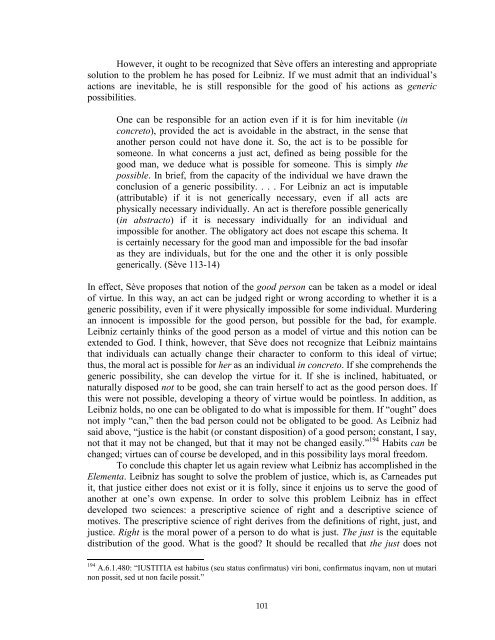Stony Brook University
Stony Brook University
Stony Brook University
Create successful ePaper yourself
Turn your PDF publications into a flip-book with our unique Google optimized e-Paper software.
However, it ought to be recognized that Sève offers an interesting and appropriate<br />
solution to the problem he has posed for Leibniz. If we must admit that an individual’s<br />
actions are inevitable, he is still responsible for the good of his actions as generic<br />
possibilities.<br />
One can be responsible for an action even if it is for him inevitable (in<br />
concreto), provided the act is avoidable in the abstract, in the sense that<br />
another person could not have done it. So, the act is to be possible for<br />
someone. In what concerns a just act, defined as being possible for the<br />
good man, we deduce what is possible for someone. This is simply the<br />
possible. In brief, from the capacity of the individual we have drawn the<br />
conclusion of a generic possibility. . . . For Leibniz an act is imputable<br />
(attributable) if it is not generically necessary, even if all acts are<br />
physically necessary individually. An act is therefore possible generically<br />
(in abstracto) if it is necessary individually for an individual and<br />
impossible for another. The obligatory act does not escape this schema. It<br />
is certainly necessary for the good man and impossible for the bad insofar<br />
as they are individuals, but for the one and the other it is only possible<br />
generically. (Sève 113-14)<br />
In effect, Sève proposes that notion of the good person can be taken as a model or ideal<br />
of virtue. In this way, an act can be judged right or wrong according to whether it is a<br />
generic possibility, even if it were physically impossible for some individual. Murdering<br />
an innocent is impossible for the good person, but possible for the bad, for example.<br />
Leibniz certainly thinks of the good person as a model of virtue and this notion can be<br />
extended to God. I think, however, that Sève does not recognize that Leibniz maintains<br />
that individuals can actually change their character to conform to this ideal of virtue;<br />
thus, the moral act is possible for her as an individual in concreto. If she comprehends the<br />
generic possibility, she can develop the virtue for it. If she is inclined, habituated, or<br />
naturally disposed not to be good, she can train herself to act as the good person does. If<br />
this were not possible, developing a theory of virtue would be pointless. In addition, as<br />
Leibniz holds, no one can be obligated to do what is impossible for them. If “ought” does<br />
not imply “can,” then the bad person could not be obligated to be good. As Leibniz had<br />
said above, “justice is the habit (or constant disposition) of a good person; constant, I say,<br />
not that it may not be changed, but that it may not be changed easily.” 194 Habits can be<br />
changed; virtues can of course be developed, and in this possibility lays moral freedom.<br />
To conclude this chapter let us again review what Leibniz has accomplished in the<br />
Elementa. Leibniz has sought to solve the problem of justice, which is, as Carneades put<br />
it, that justice either does not exist or it is folly, since it enjoins us to serve the good of<br />
another at one’s own expense. In order to solve this problem Leibniz has in effect<br />
developed two sciences: a prescriptive science of right and a descriptive science of<br />
motives. The prescriptive science of right derives from the definitions of right, just, and<br />
justice. Right is the moral power of a person to do what is just. The just is the equitable<br />
distribution of the good. What is the good? It should be recalled that the just does not<br />
194 A.6.1.480: “IUSTITIA est habitus (seu status confirmatus) viri boni, confirmatus inqvam, non ut mutari<br />
non possit, sed ut non facile possit.”<br />
101
















